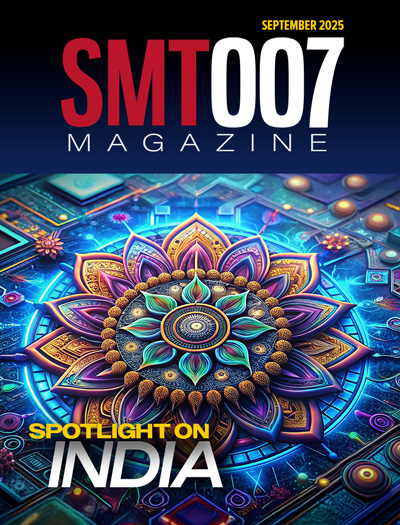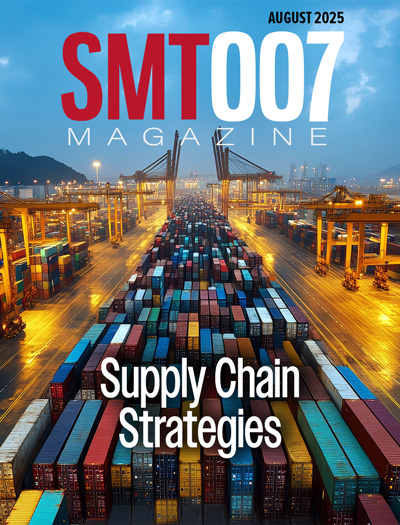-

- News
- Books
Featured Books
- smt007 Magazine
Latest Issues
Current Issue
Spotlight on India
We invite you on a virtual tour of India’s thriving ecosystem, guided by the Global Electronics Association’s India office staff, who share their insights into the region’s growth and opportunities.

Supply Chain Strategies
A successful brand is built on strong customer relationships—anchored by a well-orchestrated supply chain at its core. This month, we look at how managing your supply chain directly influences customer perception.

What's Your Sweet Spot?
Are you in a niche that’s growing or shrinking? Is it time to reassess and refocus? We spotlight companies thriving by redefining or reinforcing their niche. What are their insights?
- Articles
- Columns
- Links
- Media kit
||| MENU - smt007 Magazine
Global Impact on European PCB Fabrication: EIPC Summer Conference 2017, Day 2
June 15, 2017 | Pete Starkey, I-Connect007Estimated reading time: 12 minutes
Switching role from presenter to moderator, Paul Waldner introduced the final conference session, on solder mask and conformal coatings, and his first presentation came from the ever-popular Don Monn from Taiyo America, discussing solder mask for direct imaging. Monn’s word of the day was “Yields.” And what was affecting yields? “Registration! If you optimise registration in every department in the shop you would immediately increase your throughput and, more importantly, your profits!” For liquid photoimageable solder mask, direct imaging was the best option for achieving optimum registration, but what were the right UV wavelengths to suit the photoinitiator system? A typical LPI solder mask required a peak at 365 nm for surface cure and one at 405 nm for through-cure, and for flood exposure this could be achieved with a gallium-doped mercury lamp. But early direct imaging systems used a laser source with a peak at 355 nm, and it was necessary for the solder mask supplier to formulate his photoinitiator system specifically for this wavelength. More recently, direct imaging systems using laser diodes gave more flexibility, and dual source machines enabled the laser output to be tuned to suit the photoinitiator which could then be formulated to achieve the optimum balance between surface- and through-curing of the solder mask. This balance had a direct effect on sidewall geometry, and Monn showed real examples of solder-dam microsections illustrating the importance of getting this balance right.
Don Monn’s presentation set the scene perfectly for Uwe Altmann, Orbotech’s specialist in direct imaging systems, to discuss higher performance solutions for a wide range of solder mask applications. The obvious benefits of direct imaging of solder mask were the elimination of photo-tools and accuracy in registration. But the big challenge was the number of different solder mask inks on the market—ten suppliers and literally hundreds of ink variants, with different colours, different surface brightness, different photoinitiator systems and formulated for different coating methods. Consequently, there was no “one set-up fits all” opportunity. A different energy set-up was required per manufacturer and per application method, coating thickness, developing process, final finish requirement and reliability specification. When designing a direct imaging system for solder mask, it was necessary to consider imaging speed, adhesion of fine dams in the developing process and final finishing, good line quality and sidewall profile, registration accuracy and high depth of focus, as well as the flexibility to image many different solder mask types. Orbotech had developed a direct imager specifically for solder mask and Altmann gave a detailed description of its technical features and performance capabilities. In summary, the system featured a one-pass digital micro-mirror engine with twelve optical heads to enable one-shot exposure, a dual-table transport mechanism so that one table could be loading and registering while the other was imaging, patented high power LED optics with wide depth of focus, and a partial scaling option.
From solder mask to conformal coating, Stefan Schröder from Lackwerke Peters in Germany discussed requirements for conformal coatings today and in the future. In automotive applications, the objective was protection from moisture and electro-corrosion under thermal cycling conditions with dew formation, and typical testing subjected comb-type coupons, coated and uncoated, to alternating temperature and humidity stress. It was expected that in future, temperature stress limits would increase from -40º +125 °C to -65 +155°C or higher, with increased requirements for media and noxious gas resistance. In addition, there was a drive towards lower energy costs for application and curing, and reduced solvent emissions.
Present-day conformal coatings fell into two general classifications: oxidative curing and physical drying. Oxidative curing coatings had the benefit of sufficient resistance to media and good adhesion, but the crosslinking reaction was slow and difficult to monitor, electrical insulation against moisture was limited, and low-molecular-weight substances tended to separate during crosslinking. Physical drying coatings were rapid drying, with very good moisture insulation and resistance against hydrolysis, but tended to be low solids content, thermoplastic and with limited resistance against media. And some of the solvents used could present health risks.
For the next generation, thixotropic conformal coatings would offer improved coverage of sharp-edged component leads and a good balance between edge coverage and flowing. Optimal edge coverage would give improved climate resistance. But these materials would need to be applied by spraying. Dam-and-fill conformal coatings would offer the ability to micro-encapsulate fine-pitch-pins and build barriers to prevent migration. Schröder discussed the formulation options for two-component polyurethane and polyacrylic resin systems. Next generation UV technologies would offer solvent-free silicone thick film coatings or solvent-free silicone-free thick film coatings with a dual curing mechanism: fast UV curing, together with moisture-initiated reaction in shadowed areas.
Back to solder mask imaging for the final presentation of the conference. Michel van den Heuvel, from Ucamco in Belgium, discussed broad multi-wavelength UV-LED technology for direct imaging of solder mask. He described the mechanism of digital micro-mirror projection devices, used in conjunction with multi-wavelength UV-LEDs in the 350 nm to 440 nm range, to give a combination of high power and long life. Expanding on Donn Monn’s comments on the need to balance the absorption and transmission of UV energy through the solder mask to achieve the right combination of surface cure, through cure, adhesion to substrate and sidewall geometry, he explained the benefits of mixing 365 nm, 385 nm and 405 nm wavelengths. A meaningful analogy was a hamburger: a single wavelength UV laser cooked the outside but left the inside raw, whereas a multi-wavelength LED laser cooked it all the way through! The balance of wavelengths could be tuned to suit the photoinitiator system of a particular solder mask and, using a Stouffer step-wedge as a measure, van den Heuvel demonstrated that a 3-wavelength UV-LED mix gave 1-2 steps higher than a 2-wavelength mix for the same exposure power.
Wrapping-up the proceedings after two days of top-class technical presentations, interactive question-and-answer sessions and networking opportunities, Alun Morgan thanked the sponsors for their generous support, the paper selection committee for putting together such a comprehensive and balanced programme, the moderators for managing the conference sessions, the presenters for sharing their knowledge and experience, and the delegates for their attention. Particular thanks were due to EIPC Executive Director Kirsten Smit-Westenberg and Event Manager Carol Pelzers for their faultless all-round organisation of an outstanding event. Looking to the future, Morgan announced that the Winter Conference would be held in Lille in France, February 1–2, 2018, and to expect a memorable celebration of EIPC’s 50th anniversary in September 2018.
I am once again indebted to Alun Morgan for kindly allowing me to use his photographs.
Wrap-up video interview:
Testimonial
"We’re proud to call I-Connect007 a trusted partner. Their innovative approach and industry insight made our podcast collaboration a success by connecting us with the right audience and delivering real results."
Julia McCaffrey - NCAB GroupSuggested Items
Koh Young, Fuji, and Kurtz ERSA Drive Smart Manufacturing Solutions for EV and Automotive Electronics at Kunshan, China Technical Seminar
09/11/2025 | Koh YoungKoh Young Technology, the global leader in True 3D measurement-based inspection solutions, partnered with Fuji Corporation and Kurtz ERSA to host an exclusive technical seminar for leading automotive manufacturers in East China. Held on September 4 at Fuji’s factory in Kunshan, the event gathered participants representing over 35 companies.
MacDermid Alpha Presents at SMTA New Delhi, Bangalore Chapter, on Flux–OSP Interaction
09/09/2025 | MacDermid Alpha Electronics SolutionsMacDermid Alpha contributes technical insights on OSP solderability at the Bangalore Chapter, SMTA reinforcing commitment to knowledge-sharing and industry collaboration.
Electra’s ElectraJet EMJ110 Inkjet Soldermask Now in Black & Blue at Sunrise Electronics
09/08/2025 | Electra Polymers LtdFollowing the successful deployment of Electra’s Green EMJ110 Inkjet Soldermask on KLA’s Orbotech Neos™ platform at Sunrise Electronics in Elk Grove Village, Illinois, production has now moved beyond green.
Absolute EMS: The Science of the Perfect Solder Joint
09/05/2025 | Absolute EMS, Inc.Absolute EMS, Inc., a six-time award-winning provider of fast turnaround, turnkey contract electronic manufacturing services (EMS), is drawing attention to the critical role of 3D Solder Paste Inspection (SPI) in ensuring the reliability of both FLEX and rigid printed circuit board assemblies (PCBAs).
Indium Corporation to Highlight High-Reliability Solder Solutions at SMTA Guadalajara Expo
09/04/2025 | Indium CorporationIndium Corporation, a leading materials refiner, smelter, manufacturer, and supplier to the global electronics, semiconductor, thin-film, and thermal management markets, will feature a range of innovative, high-reliability solder products for printed circuit board assembly (PCBA) at the SMTA Guadalajara Expo and Tech Forum, to be held September 17-18 in Guadalajara, Mexico.


